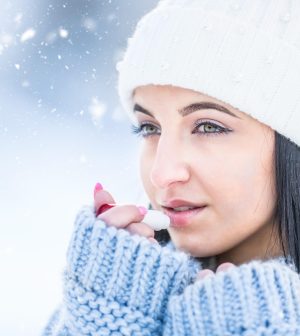- Double Mastectomy May Offer No Survival Benefit to Women With Breast Cancer
- Toxic Lead Found in Cinnamon Product, FDA Says
- Certain Abbott Blood Sugar Monitors May Give Incorrect Readings
- Athletes Can Expect High Ozone, Pollen Counts for Paris Olympics
- Fake Oxycontin Pills Widespread and Potentially Deadly: Report
- Shingles Vaccine Could Lower Dementia Risk
- Your Odds for Accidental Gun Death Rise Greatly in Certain States
- Kids From Poorer Families Less Likely to Survive Cancer
- Tough Workouts Won’t Trigger Cardiac Arrest in Folks With Long QT Syndrome
- At-Home Colon Cancer Test Can Save Lives
Winter Wonderland? Not for Your Skin

Winter is no friend to the body’s delicate skin, but an expert offers three key tips: moisturize, moisturize, moisturize.
“It’s pretty intuitive, but it bears repeating,” said dermatologist Dr. David Pearson, an assistant professor at the University of Minnesota Medical School, in Minneapolis. “The environment treats our skin differently in the winter, and that means we may have to change our behaviors to acclimate.”
As temperatures and humidity levels drop, your skin loses moisture, Pearson explained in a university news release. This is especially true in a cold, dry state like Minnesota.
To help hydrate winter skin, Pearson recommends a thick moisturizing cream that has to be scooped out of a jar or squeezed out of a tube, rather than something thin that comes through a pump.
“I don’t like a lot of additives, perfumes, scents, etc. — keep it simple,” Pearson said.
When skin dries out, its ability to protect you from external allergens and infections is compromised. “Ceramides may be helpful in restoring the skin barrier, so those can be a good ingredient to look for,” he added.
Pearson said some data suggests that humidifiers may also help, but likely less so than moisturizer.
When washing, use a gentle soap and keep up your summer sunscreen routine. Even if you’re bundled up, a fair amount of UV light is reflected from the snow, Pearson said. “Prolonged exposure through outdoor activities (or long drives) can add up,” he explained.
Winter is often more difficult for people who have eczema, especially when it’s on their hands, Pearson noted. Eczema causes dry, itchy and red skin.
In cold weather, Pearson also sees vascular conditions called Raynaud’s and pernio, because he specializes in autoimmune connective tissue diseases. Symptoms can occur with cold exposure.
“Raynaud’s is the rapid onset of white or blue discoloration of the fingers and/or toes from cold exposure due to constriction of blood vessels,” he explained. “Pernio is the delayed onset of tender pink bumps on the fingers and toes 1 to 2 days after cold exposure.”
In very cold regions, frostbite, which can happen when skin temperature reaches 28° Fahrenheit or below, is another danger. That only takes 30 minutes in 0° F weather.
“Our skin isn’t physiologically equipped for unprotected, prolonged exposure to these temperatures, so be sure to put on a warm coat and hat when you’re going outside,” Pearson advised.
More information
The American Academy of Dermatology Association offers more winter skin-care tips.
SOURCE: University of Minnesota Medical School, news release, Jan. 17, 2023
Source: HealthDay
Copyright © 2024 HealthDay. All rights reserved.










